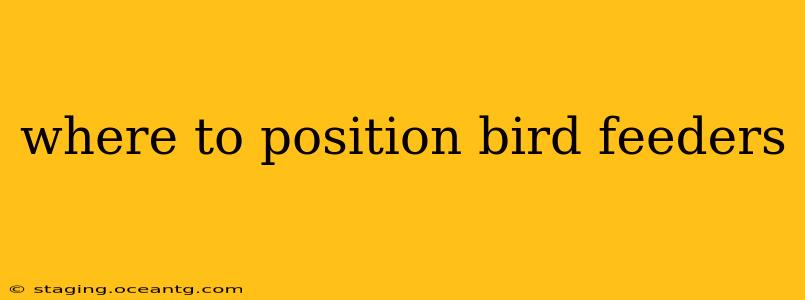Attracting birds to your backyard is a rewarding experience, offering hours of entertainment and a connection with nature. However, simply putting up a bird feeder isn't enough. The placement of your feeder significantly impacts its effectiveness and can even affect the safety of your avian visitors. Let's explore the ideal positioning strategies for your bird feeders to maximize their appeal and minimize potential problems.
How High Should a Bird Feeder Be?
This is a frequently asked question, and the answer isn't a single number. The optimal height depends on several factors, including the types of birds you want to attract, the presence of predators, and the surrounding landscape. Generally, placing your feeder between 4 and 6 feet off the ground is a good starting point. This height offers a balance between accessibility for birds and protection from ground predators like cats and raccoons. However, consider these nuances:
- Smaller birds: For smaller birds, a slightly lower height might be better, possibly even as low as 3 feet, to avoid competition from larger, more aggressive birds.
- Larger birds: Larger birds may prefer feeders placed higher up, perhaps even 8-10 feet, to reduce competition.
- Predator protection: If predators are a concern, consider placing your feeder even higher and away from dense shrubs where cats or other predators can hide.
What is the Best Location for a Bird Feeder?
Beyond height, the location itself plays a crucial role in attracting birds and keeping them safe. Ideally, your feeder should be:
- Near cover: Birds need a safe place to escape from predators. Position the feeder near shrubs, trees, or other natural cover that provides quick refuge.
- Away from windows: Collisions with windows are a significant threat to birds. Place your feeder far enough away from windows to minimize the risk. Consider adding window decals to help birds see the glass.
- Out of direct sunlight: Direct sunlight can cause the food to spoil more quickly, especially in warmer weather. A location with some shade will help keep the food fresher for longer.
- Easy to access for cleaning and refilling: Choose a spot that's convenient for you to reach for regular cleaning and refilling. This will ensure the feeder remains a safe and attractive food source.
- Away from heavy foot traffic: Avoid placing the feeder in areas where people or pets frequently pass, which can scare the birds away.
Should Bird Feeders Be in the Sun or Shade?
As mentioned above, partial shade is ideal. Direct sunlight can quickly spoil birdseed, leading to mold and attracting unwanted pests. A shady spot will help maintain the quality and freshness of the food, keeping your feathered friends healthy and happy.
How Far Apart Should Bird Feeders Be?
The distance between bird feeders depends on the size of your yard and the number of feeders. While there's no magic number, it's generally recommended to space them at least 10-15 feet apart. This helps reduce competition between birds and prevents overcrowding, promoting a more peaceful feeding experience.
What Direction Should Bird Feeders Face?
There is no definitive "best" direction to face your bird feeders. The most important factor is providing good visibility for the birds to easily spot the feeder and ensuring it's appropriately sheltered from the elements and predators.
By following these guidelines, you'll create a bird-friendly haven in your backyard, providing a safe and inviting place for your avian visitors to enjoy a delicious meal. Remember, observation is key! Pay attention to how your birds interact with the feeder and adjust its position if necessary to optimize its effectiveness.
